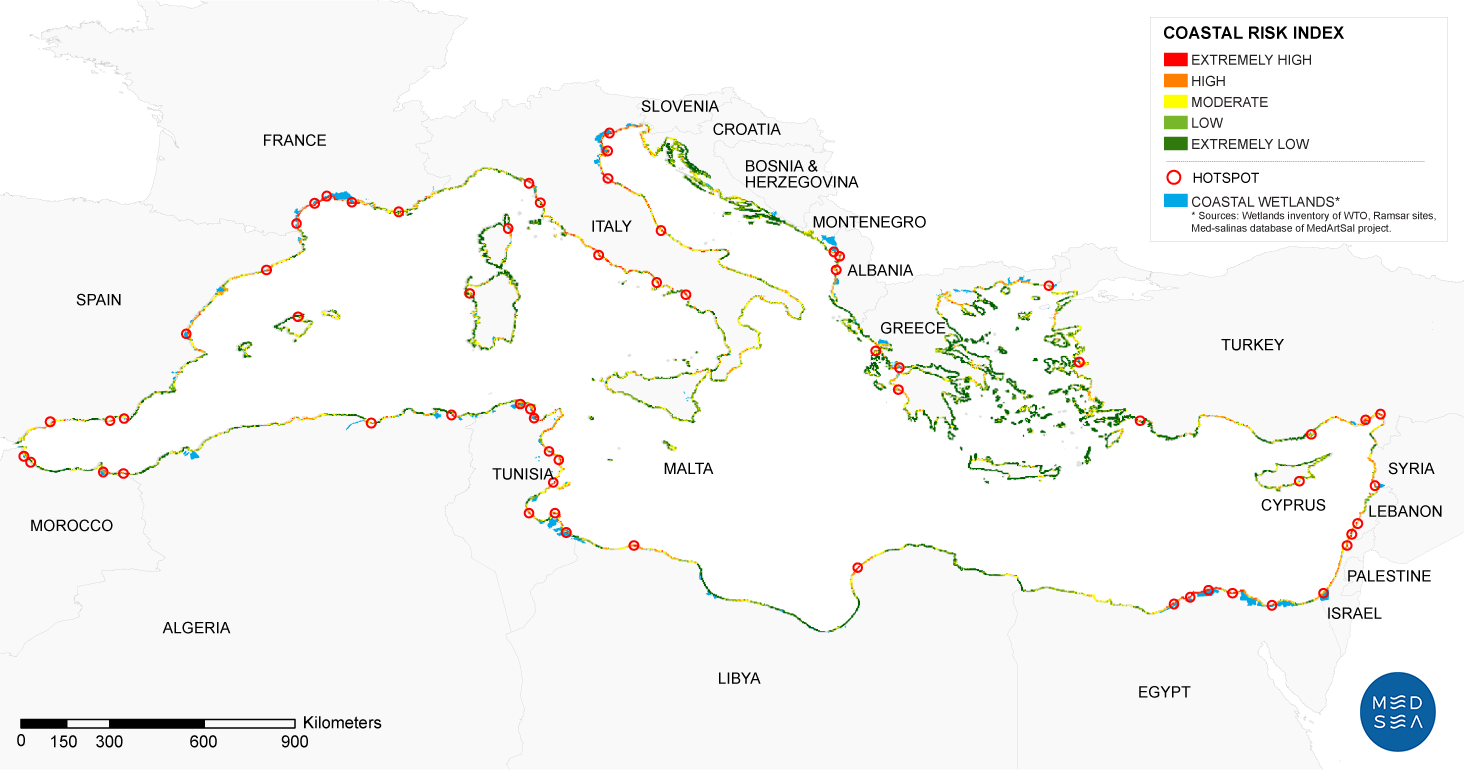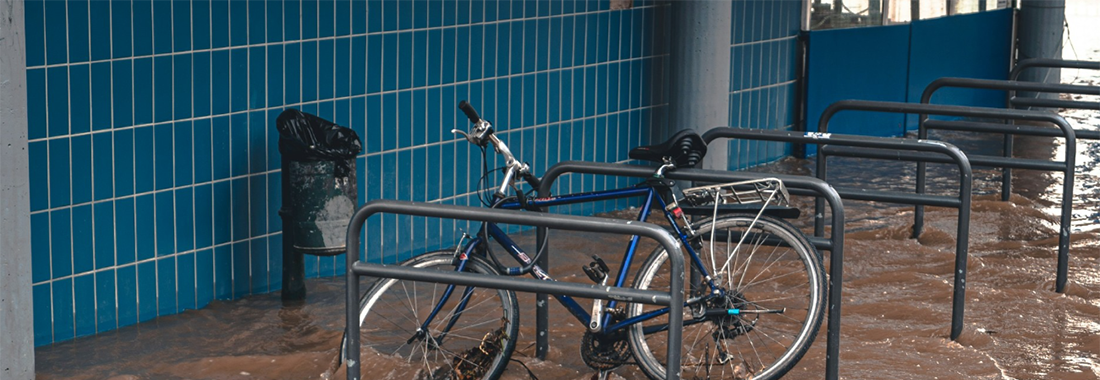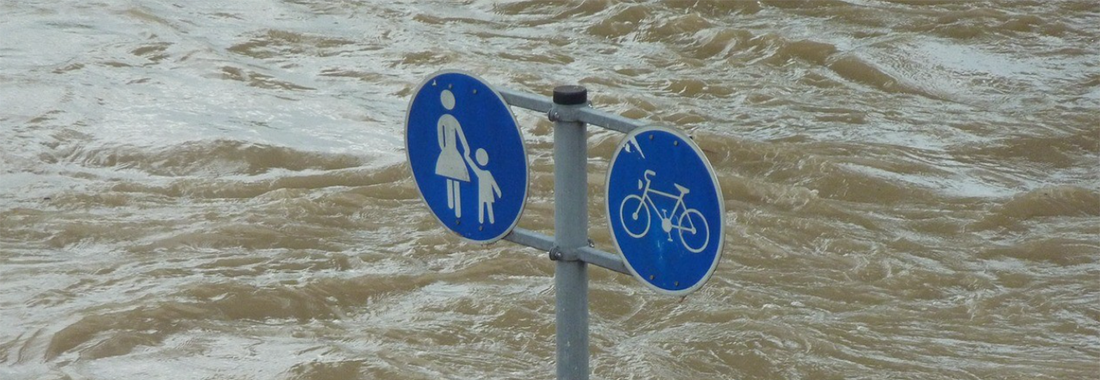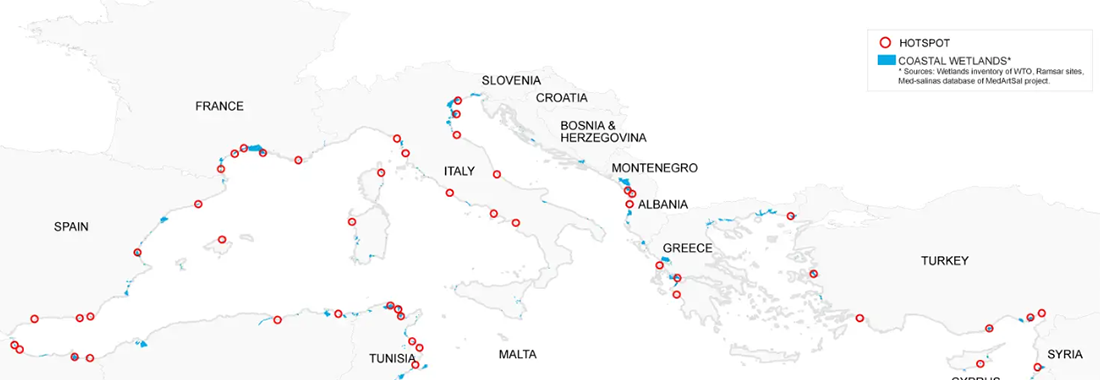The recent flash floods in Valencia are a tangible example of how extreme events linked to climate change are increasing in frequency, intensity, and duration, severely impacting the Mediterranean, a true climate "hotspot." In just a few hours, torrential rains delivered up to 490 mm of water—equivalent to an entire year’s rainfall—saturating the ground and overwhelming drainage systems. This event was fueled by the phenomenon known as DANA (Depresión Aislada en Niveles Altos), where cold air at high altitudes meets warmer air below, creating intense and persistent thunderstorms.
The extreme heat in the Mediterranean, with record-breaking surface temperatures, contributed to amplifying the storm's power. Higher sea temperatures led to more intense evaporation, resulting in an atmosphere laden with moisture, ready to release as intense rainfall. This process, where part of the thermal energy is converted into kinetic energy, intensifies not only the rainfall but also the winds associated with the storm, making the impact even more devastating.
The "Mediterranean Climate Hotspot Map" by MEDSEA (2021) is a mapping of climate risk areas (hotspots) in the Mediterranean, identifying climate hot spots and coastal wetlands, which are essential for biodiversity and climate change adaptation.
The heavy human development along the Mediterranean coast makes this area particularly exposed, as highlighted in one of our recent studies on coastal risk and the impact of climate change, "Mediterranean Climate Hotspot Map" by MEDSEA.
Valencia, located on Spain's eastern coast, is marked on the map as particularly vulnerable to climate change. Construction, infrastructure, and urbanisation in coastal and inland areas have reduced the soil's absorption capacity, increasing vulnerability to extreme events like marine flooding, which often compounds with inland flooding, creating a widespread risk along the entire coast. Yet, Valencia is not the only city at risk in the Mediterranean.
To address these extreme phenomena, it's crucial to enhance the resilience of territories and communities by adopting effective adaptation measures. Nature-based solutions (NsB), such as protecting wetlands, forests, and natural water expansion areas, are optimal options for mitigating the impact of these events.
At MEDSEA, we have long been committed to restoring and improving the ecological health of marine and coastal ecosystems, including the vital wetlands, which can absorb excess water faster than other soils, contain it, slow runoff, and mitigate damage from large-scale events. Through Wetland4Change, an Interreg Euro-MED project, with Spain and the University of Valencia as partners and a pilot site at Albufera Lagoon, we are testing two adaptation solutions thanks to wetlands: one focused on flood and inundation regulation and another on carbon storage. Coincidentally, at the end of the month, on November 28-29, we will have the project meeting in Valencia with all partners, where we will discuss natural solutions to flooding through wetlands.
Never before has research transitioned so clearly into reality, underscoring the importance of all ongoing work and the urgency to take this issue seriously, even beyond the field of professionals. In Sardinia, with the TransformAR project, we are making flood prevention solutions tangible for the fishing industry, installing monitoring sensors in the San Giovanni lagoon.
Reshaping territories to better respond to extreme climate events has become a priority to protect communities and preserve Mediterranean ecosystems.
We are all at risk!
Manuela Puddu
MEDSEA wetland representative and environmental engineer

Latest news

ARTEMIS: Marine Reforestation Activities Begin in Northern Sardinia
Marine reforestation efforts under the European Interreg Euro-MED “ARTEMIS” project have officially begun off the northern coast of Sardinia, in Santa Teresa Gallura.

REST-COAST: Strategies for the Protection of European Coasts Outlined in Catania
From March 24 to 27, 2025, the annual meeting of the European project REST-COAST, funded by the Horizon 2020 program, was held in Catania. The meeting marked a key milestone toward the…

A Forest for Bees Takes Root in Sardinia: Restoring Nature, Supporting Pollinators
The planting operations for the first Forest for Bees installation—a forest for bees—have been completed in Sennariolo (OR). This is a special one-hectare forest dedicated to bees and pollinators, essential insects for food…

Altare Hosts RICREA Meeting: Shared Strategies Through Ecological Transition Contracts
The third Steering Committee of the RICREA project – Collaborative Network for the Capitalization of REtrAlags – was held in Altare (Savona). The project is funded by the Italy–France Maritime Interreg Programme.

GRRinPORT2: Innovation and Cross-Border Cooperation for Environmental Protection of Ports
On March 20–21, 2025, the Kickoff Meeting of the GRRinPORT2 project – Management of water, waste, and sediments to reduce pollution in ports – was held at the DESTEC Department of the University of Pisa…

MEDSEA Launches the Wetland4Change Project in Terralba to test and validate climate change's solutions
On Friday, March 14, 2025, in the council chamber of Terralba, MEDSEA held a meeting with the Municipality of Terralba to officially introduce Wetland4Change to stakeholders (productive activities, as well as institutional…

In Crete with ARTEMIS to protect seagrass meadows: 2nd Consortium Meeting
From March 4th to 6th, 2025, Heraklion (Crete) hosted the mid-term meeting of the ARTEMIS Interreg Euro-MED Natural Heritage project, organized by the Hellenic Marine Research Centre. This was a crucial moment to…

MEDSEA Heads to Tallinn for the Blue4All Consortium Meeting
Last January, the Blue4All project team gathered in Tallinn for the Consortium Meeting, marking the project's halfway point. The event, hosted by the local partner Keskkonnaamet/Estonian Environmental Board and the University of Tartu, brought together all 22 project partners from across…

ImPelaghiamoci: A Year of Initiatives to Learn About and Protect Cetaceans with the Municipality of Sassari
Promoting greater knowledge of the resident cetaceans in the Pelagos Sanctuary*, a transboundary marine protected area encompassing France, Liguria, Tuscany, and Sardinia, to improve the protection and conservation of these species…

Reforestation Operations Resume in Montiferru: A Forest for Bees by MEDSEA
Reforestation efforts in Montiferru, led by MEDSEA, are back on track. Following the planting of the first 5 hectares of olive trees, holm oaks, and Mediterranean shrubs, the focus now shifts to melliferous plants to…

25 Events in Sardinia for World Wetlands Day
Wetlands such as ponds, lagoons, lakes, rivers, and peatlands form an endless world of aquatic ecosystems. In Sardinia, the call to explore these habitats is open this February with the Sardinian edition of World Wetlands Day.

COASTRUST: Launching Sustainable Coastal Management in Domus de Maria Sardinia
The activities of the COASTRUST project, funded by the European Interreg Euro-MED program, have officially begun in Sardinia. The initiative aims to promote shared environmental management in the Mediterranean's coastal areas, addressing anthropogenic pressures…

Join the World Wetlands Day Sardinia 2025 Calendar: register your Event by January, 22nd
World Wetlands Day is celebrated every year on February 2, marking the adoption of the Convention on Wetlands signed on February 2, 1971, in Ramsar, on the shores of the…

MEDSEA joins the Camargue Red Alert with the Mediterranean Alliance for Wetlands to save birdlife
The MEDSEA Foundation has officially joined 73 other international organizations in signing the Camargue Red Alert, a collective call to action to safeguard the Camargue wetlands in France.

Wetland4Change: MEDSEA in Valencia to Explore Natural Climate Solutions Through Wetlands
The MEDSEA team participated in the second Consortium meeting of the Wetland4Change project in Valencia from November 26 to 28, 2024. The meeting was organized by local project partners, the…

Malta’s First Posidonia Meadow Restoration Project Led by MEDSEA Foundation
Different islands, but similar issues for marine ecosystems, which are heavily threatened by unregulated anchoring from recreational boating and illegal trawling. In Malta, as in Sardinia, the damage is particularly…
- 1
- 2
- 3
- 4



